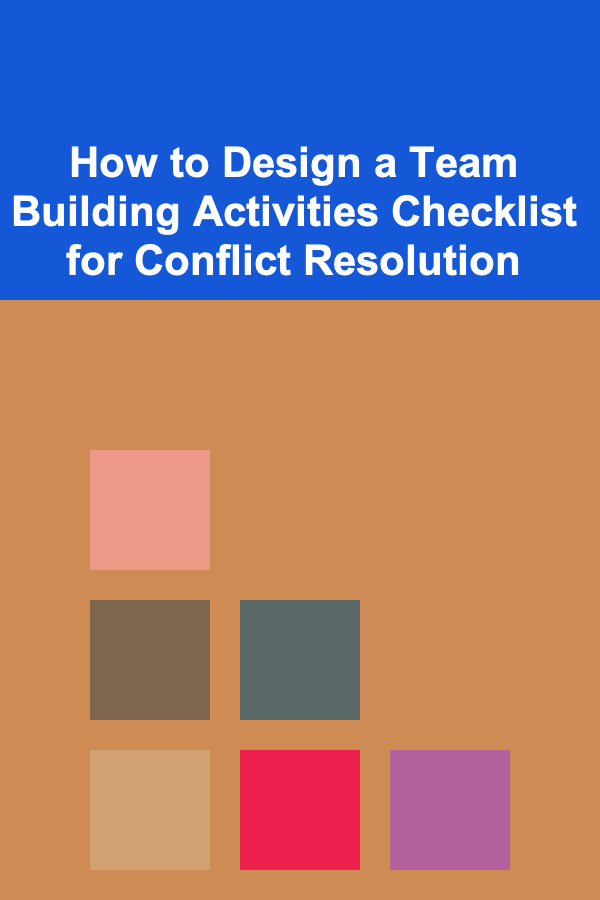
How to Design a Team Building Activities Checklist for Conflict Resolution
ebook include PDF & Audio bundle (Micro Guide)
$12.99$7.99
Limited Time Offer! Order within the next:

Effective conflict resolution within teams is crucial for maintaining productivity, morale, and collaboration in any organization. Conflict, when not managed properly, can escalate, causing disruptions in work processes, communication breakdowns, and diminished team cohesion. Fortunately, one of the most effective ways to prevent and resolve conflicts is through team-building activities that promote better communication, trust, and mutual understanding among team members.
This guide will walk you through the process of designing a team-building activities checklist focused on conflict resolution. It will provide actionable steps, tips, and key considerations for creating activities that will help your team work together more harmoniously while resolving issues constructively.
Assess the Team's Current Dynamics
Before you can design effective team-building activities, it's important to understand the current state of your team's dynamics. This step involves identifying the areas where conflict frequently arises and recognizing the types of interpersonal challenges the team faces.
Key Steps:
- Conduct Surveys or Interviews: Use surveys or one-on-one interviews to gather feedback from team members about any issues they face. Look for patterns in the responses related to communication, decision-making, or interpersonal struggles.
- Observe Team Interactions: Watch how the team interacts during meetings, collaborative tasks, or social events. Are there communication barriers? Do certain individuals dominate the conversation? Is there a lack of trust or misunderstanding between team members?
- Identify Core Issues: Whether it's competition, unclear roles, or cultural differences, pinpoint the root causes of conflicts. This will help you design activities that address specific issues.
Set Clear Objectives for Conflict Resolution
Once you've assessed your team's dynamics, the next step is to define clear objectives for the team-building activities. These objectives should align with the specific conflicts and challenges you aim to resolve. Without clear goals, team-building exercises may fall short of achieving meaningful change.
Key Objectives to Consider:
- Improve Communication: Many conflicts arise due to poor communication. Your activities should focus on enhancing both verbal and non-verbal communication skills.
- Foster Trust and Empathy: Activities should help team members get to know each other better, build mutual respect, and understand each other's perspectives.
- Encourage Collaboration Over Competition: Conflict can sometimes be driven by unhealthy competition. Activities that promote collaboration over individual success can help shift the focus toward teamwork.
- Develop Problem-Solving Skills: Conflict often arises from different approaches to problem-solving. Activities should encourage collaborative problem-solving and finding common ground.
- Reduce Stress and Build Resilience: High-stress environments can exacerbate conflicts. Providing activities that reduce stress and encourage a resilient mindset can make team members better equipped to handle disagreements.
Select Conflict Resolution Activities
Once you've defined your objectives, it's time to select the right activities. The best activities are those that allow your team to address conflicts in a controlled, constructive manner. Below are some ideas for conflict-resolution-focused team-building activities:
a. Role-Playing Scenarios
Role-playing allows team members to step into each other's shoes and gain a deeper understanding of different perspectives. This activity is particularly useful for resolving interpersonal conflicts or misunderstandings.
How it Works:
- Create scenarios that reflect common conflicts within your team (e.g., miscommunication, differing work styles, or decision-making disagreements).
- Assign team members to play roles that are opposite to their usual positions (e.g., the boss, a colleague with opposing views).
- After the role-play, facilitate a discussion on how the conflict was handled and what could be improved.
b. Active Listening Exercises
Active listening is a critical skill for resolving conflicts. By practicing this skill, team members learn to listen with empathy and without judgment, which can significantly reduce misunderstandings.
How it Works:
- Pair up team members and assign one person to speak about a topic (personal or work-related) for 3-5 minutes.
- The other person must listen attentively without interrupting and then summarize what they've heard to ensure they understood correctly.
- Afterward, switch roles. This exercise promotes empathy and helps people feel heard, which is essential in conflict resolution.
c. Team Collaboration Challenges
Collaboration challenges focus on teamwork, problem-solving, and creative thinking. These activities help teams shift their focus from competition to cooperation.
How it Works:
- Divide the team into smaller groups and provide them with a challenge that requires collaboration to solve (e.g., building a tower with limited materials, creating a strategy for a hypothetical problem).
- The challenge should encourage communication, resource-sharing, and cooperative decision-making.
- Afterward, debrief the activity by discussing the strategies used to overcome challenges and how these strategies can be applied to resolve real-life conflicts.
d. Conflict Resolution Workshops
While activities are important, providing structured learning about conflict resolution can be equally beneficial. A workshop can teach team members essential conflict-resolution techniques and strategies.
How it Works:
- Organize a workshop led by a facilitator or conflict-resolution expert who can teach practical techniques such as negotiation, mediation, and de-escalation.
- Include exercises and role-playing scenarios where team members practice resolving conflicts in a safe, supportive environment.
- Follow the workshop with a group discussion where team members can reflect on the skills they've learned and how they can apply them to real conflicts.
e. Trust-Building Activities
Trust is a cornerstone of effective conflict resolution. When team members trust each other, they're more likely to approach conflicts with an open mind and a willingness to find common ground.
How it Works:
- Use activities like the "Trust Fall," where one person falls backward, relying on the other to catch them. This builds trust in a tangible way.
- Alternatively, try exercises that involve vulnerability, such as sharing a personal story or experience in front of the team, which can foster deeper emotional connections and understanding.
- Trust-building activities should be safe, voluntary, and respectful of personal boundaries.
Create a Schedule and Timeline for Activities
To ensure your team-building efforts are successful, it's essential to plan and schedule the activities effectively. Determine the best time to introduce conflict resolution exercises, taking into account your team's workload, project timelines, and availability.
Key Tips:
- Frequency: Aim to incorporate team-building activities into regular team meetings or as part of a larger team retreat. This helps reinforce conflict resolution skills over time.
- Duration: Choose activities that fit into your team's schedule. Some exercises, like role-playing, can take 30 minutes, while workshops or challenges might require a full day.
- Pacing: Don't overload your team with too many activities at once. Allow time for reflection and application between sessions, as this helps reinforce lessons learned.
Measure and Evaluate the Effectiveness of the Activities
After completing the team-building activities, it's essential to assess their impact. Measuring the effectiveness will help you understand which exercises were most beneficial in resolving conflicts and which areas need further attention.
Evaluation Methods:
- Surveys: Distribute anonymous surveys to team members asking for feedback on the activities and their impact on team dynamics. Ask if they feel more confident in resolving conflicts and whether their relationships with colleagues have improved.
- One-on-One Conversations: Have informal check-ins with team members to gather qualitative feedback. Use these conversations to learn more about their experiences and identify areas of improvement.
- Observe Changes in Behavior: Monitor the team's behavior in subsequent meetings or tasks. Are they communicating more effectively? Are conflicts being handled more constructively?
Make Adjustments Based on Feedback
Conflict resolution is an ongoing process, and so should be your team-building efforts. Based on the feedback and observations from your evaluation, make adjustments to your approach. Consider adding new activities, tweaking existing ones, or adjusting the objectives to better meet your team's needs.
Ongoing Commitment:
- Continue Training: Conflict resolution isn't a one-time event. Regularly revisit conflict resolution training and team-building exercises to reinforce the skills learned.
- Create a Safe Environment for Open Dialogue: Encourage open communication within the team by providing opportunities for members to express concerns in a safe and respectful environment. This proactive approach can help prevent conflicts from escalating.
Conclusion
Designing a team-building activities checklist focused on conflict resolution is an essential step toward fostering a more harmonious and productive work environment. By carefully assessing your team's needs, setting clear objectives, selecting the right activities, and continuously evaluating your efforts, you can create a culture of trust, understanding, and effective conflict resolution.
The key to success lies in maintaining an open and supportive environment where conflicts are seen as opportunities for growth rather than threats. With the right approach, team-building activities can transform conflicts into valuable learning experiences that strengthen team dynamics and lead to better collaboration.
Reading More From Our Other Websites
- [Home Space Saving 101] How to Downsize Your Possessions for a More Spacious Home
- [Rock Climbing Tip 101] Essential Training Tips to Boost Your Climbing Fitness
- [Home Budget 101] How to Make the Most of Your Home's Square Footage on a Budget
- [Home Storage Solution 101] How to Build Your Own DIY Closet Organizer
- [Organization Tip 101] Mixing Styles: The Art of Eclectic Home Decorating
- [Mindful Eating Tip 101] From Plate to Presence: A Week‑Long Mindful Eating Dinner Plan for Busy Professionals
- [Personal Care Tips 101] How to Apply Mascara Without Getting It on Your Eyelids
- [Star Gazing Tip 101] Essential Tips for Setting Up and Using a Beginner Telescope
- [Home Storage Solution 101] How to Store Your Wine Collection Without Taking Up Space
- [Organization Tip 101] Tips for Efficient Tile Removal with Minimal Damage to Walls

Brand Ambassador Handbook: Creating Impactful Connections and Loyalty
Read More
How To Build a Skincare Routine for Swimmers
Read More
How to Create a Spa-Like Bathroom with Proper Lighting
Read More
How to Provide Excellent Customer Service in the Transport Business
Read More
How to Set Up a Minimalist Bedroom for Better Sleep
Read More
How to Create a Detailed Renovation Timeline Checklist
Read MoreOther Products

Brand Ambassador Handbook: Creating Impactful Connections and Loyalty
Read More
How To Build a Skincare Routine for Swimmers
Read More
How to Create a Spa-Like Bathroom with Proper Lighting
Read More
How to Provide Excellent Customer Service in the Transport Business
Read More
How to Set Up a Minimalist Bedroom for Better Sleep
Read More